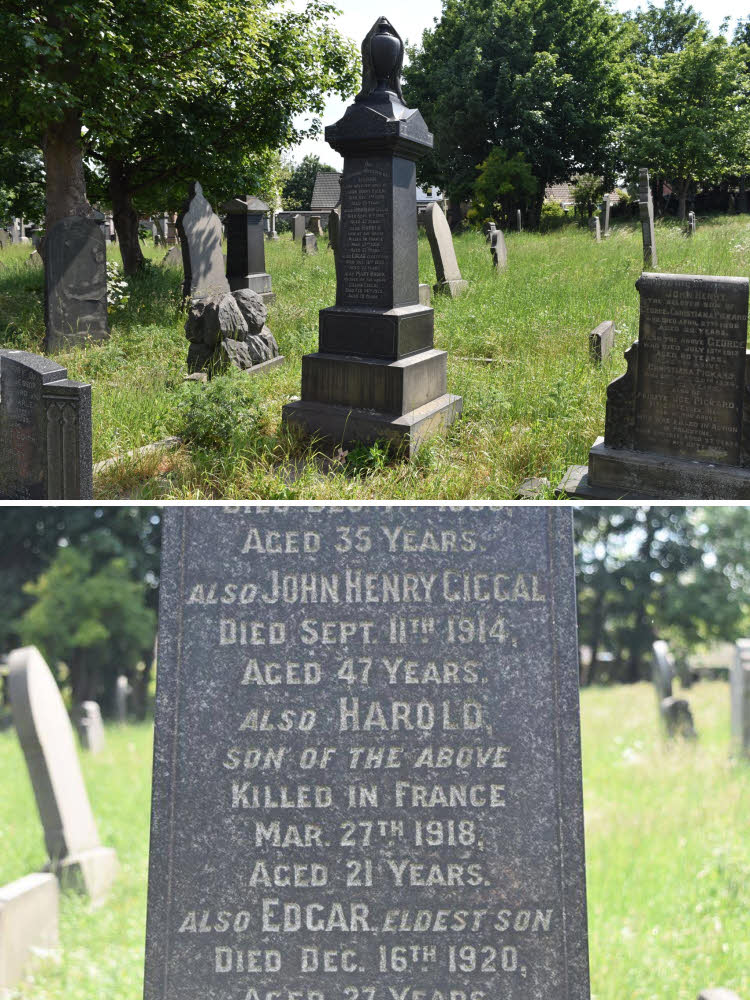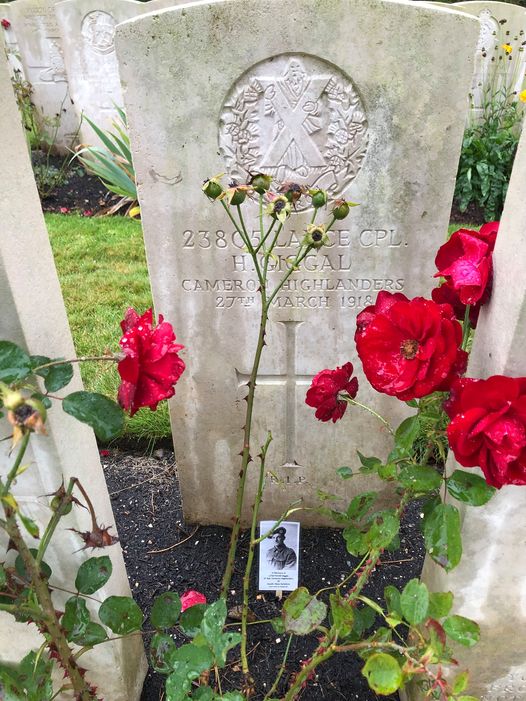
Harold Giggal was born in Ossett on the 30th October 1896 and baptised at the Ossett Green Congregational Church, The Green on 13th December 1896. Harold was the second son of overlooker and wool extractor John Henry Giggal and Lillian (nee Senior) who married at Wakefield Cathedral on the 30th of November 1892. John Henry Giggal’s abode was given as Ossett and he was the son of manufacturer, David Giggal. Lillian then aged 21, was the daughter of Abraham Smith Senior, gentleman of Westgate Common, Wakefield. One of the witnesses to the marriage was Edward Clay. In 1893, Giggal & Clay were Mungo Manufacturers on Healey Lane, Ossett.
Both of Harold Giggal’s parents were Ossett born and, in 1901, they were living on Dearden Street with their two sons Edgar and Harold. Harold’s mother Lillian died in 1906 at the early age of 35. In 1911, his father, John is a Mungo Manufacturer aged 46 years and a widower living with his two sons, Edgar (17) and Harold (15) at Mallin House, Queens Street, Ossett, a spacious 9-roomed house. Harold’s grandmother, twice widowed, Mary Brook aged 66 is living with the family. Edgar is working in his father’s mungo manufacturing business and Harold is still at Wakefield Queen Elizabeth’s Grammar School. Harold’s father John Henry Giggal died in the summer of 1914 aged 48.
Harold Giggal enlisted in the army sometime in 1916 as a volunteer. It is not known whether he joined the Queen’s Own Cameron Highlanders at the time of enlistment or whether he was transferred from another regiment. Unfortunately his service and medal records have not survived.
Lance-Corporal Giggal died on the 27th March 1918 from wounds sustained from the heavy fighting during the first Battle of Bapaume on the 24th or the 25th March 1918. Harold Giggal’s regiment was part of the 9th (Scottish) Division of General Hubert Gough’s Fifth Army located east of Bapaume at Gouzeaucourt.
The “Ossett Observer” 1 had this report of Harold Giggal’s death:
“Lance-corporal Harold Giggal, who died from wounds in a hospital in France on the 27th ult. was in the Cameron Highlanders. He was the younger son of the late Mr. John Henry Giggal, Ossett and a nephew of Mr. Francis Giggal, with whom he had latterly been associated in business. He enlisted voluntarily more than two years ago, and was 21 years of age in October last, when he was home on leave. At a meeting of the Ossett Congregational Church on Thursday, a vote of thanks was passed with the relatives, in which many of the young man’s personal friends will join.”
The 5th (Service) Battalion of the Queen’s Own Cameron Highlanders was formed at Inverness in August 1914 as part of K1 and came under orders of 26th Brigade in the 9th (Scottish) Division. They moved to Aldershot and in February 1915 went to Bordon. They landed at Boulogne on the 10th of May 1915. The action at the first Battle of Bapaume that Harold Giggal’s 9th (Scottish) Division was involved in is recorded here:2
“March 1918 saw the 9th (Scottish) Division in the line before Gouzeaucourt, east of Bapaume, where the German offensive, launched on the 21st March, forced the 9th into a fighting withdrawal, in which a large part of the South African Brigade was cut off and wiped out, fighting to the last. By the 26th March, the strength of the Division had been reduced to 1,340 men and two days later they were withdrawn from the line. The 9th (Scottish) Division had gone down fighting, and had earned the admiration of friend and foe alike. By their dogged resistance, the men of the division had bought the time needed to stem the German advance, whilst extracting a heavy toll of the enemy. They had significantly helped to save the British Army from a disaster, earning the praise of Sir Douglas Haigh: “Great gallantry has been shown by the troops engaged in the fighting – the 19th and 9th Divisions have distinguished themselves by the valour of their defence.”
Harold Giggal is buried in Doullens Community Cemetery Extension No. 1 3, Somme, France at grave reference V. A. 57. Doullens was Marshal Foch’s headquarters early in the First World War and the scene of the conference in March 1918, after which he assumed command of the Allied armies on the Western Front. From the summer of 1915 to March 1916, Doullens was a junction between the French Tenth Army on the Arras front and the Commonwealth Third Army on the Somme. The citadelle, overlooking the town from the south, was a French military hospital, and the railhead was used by both armies. In March 1916, Commonwealth forces succeeded the French on the Arras front and the 19th Casualty Clearing Station came to Doullens, followed by the 41st, the 35th and the 11th. By the end of 1916, these had given way to the 3rd Canadian Stationary Hospital (which stayed until June 1918) and the 2/1st Northumbrian Casualty Clearing Station. From February 1916 to April 1918, these medical units continued to bury in the French extension (No 1) of the communal cemetery. In March and April 1918 the German advance and the desperate fighting on this front threw a severe strain on the Canadian Stationary Hospital. The extension was filled, and a second extension begun on the opposite side of the communal cemetery.

Above: Positions of Allied and German troops in March 1918 during the Operation Michael, German offensive.
Harold’s elder brother Edgar Giggal also served during WW1. On the 3rd of December 1915 he enlisted at Ossett and was appointed to the 15th London Regiment on the 22nd January 1916. Edgar was 22 years and 7 months old on enlistment, a rag merchant living at 8, Brook Street, Ossett. Private 62686 Edgar Giggal was discharged on medical grounds (sickness) on the 29th of May 1916. He did not serve abroad and he was granted a War Badge and Certificate on the 17th of November 1916 with an accompanying instruction that “the Badge will be worn on the right breast or the right lapel, but not in naval or Military uniform. Duplicates of the Badge or Certificate cannot be issued under any circumstances.” Edgar was also awarded a pension of 5/6d for 26 weeks from the 8th of April 1918.

Above: The Giggal grave at St. John’s Methodist Chapel showing the memorial to Harold Giggal, the son of John Henry Giggal. Picture courtesy of Lisa Jennings.

CWGC heastone photograph courtesy of Mark Smith
References:
1. “Ossett Observer”, 6th April 1918.
2. “Scottish Divisions in the World Wars”, by Mike Chappell, Osprey Publishing 1994, ISBN 1-85532-469-5